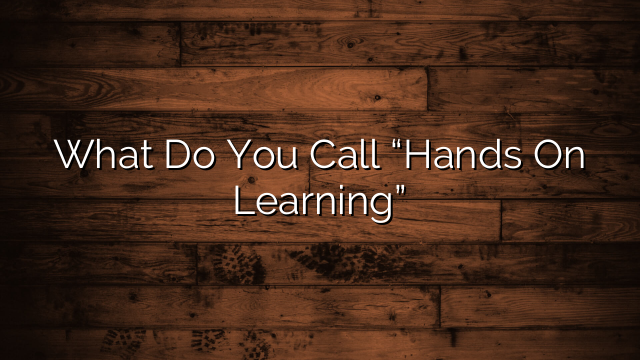In the realm of education, there exists a teaching approach that goes beyond traditional classroom lectures and textbooks. It is a method that immerses students in the learning process, allowing them to actively engage with the subject matter at hand. This approach, known as hands-on learning, is characterized by its emphasis on experiential activities and direct manipulation of materials or objects. By doing so, students are able to develop a deeper understanding of concepts and principles, while also honing their problem-solving skills and critical thinking abilities.
Hands-on learning offers numerous benefits for students of all ages. Research has shown that it enhances retention and recall of information, as well as fosters creativity and innovation. Moreover, this approach promotes active participation and collaboration among learners, leading to a more dynamic and interactive classroom environment.
Throughout this article, we will explore the definition and principles of hands-on learning, delve into its various benefits for students across different educational settings, provide examples of hands-on learning activities, discuss strategies for implementing this approach effectively in classrooms or other learning environments.
Whether you are an educator seeking new instructional techniques or a curious reader eager to learn more about innovative teaching methods – this article aims to offer valuable insights into the world of hands-on learning.
Key Takeaways
- Hands-on learning emphasizes experiential activities and direct manipulation of materials or objects.
- Research shows that hands-on learning enhances retention, recall, creativity, and innovation.
- Hands-on learning fosters active participation and collaboration among learners.
- Benefits of hands-on learning include increased student engagement, development of critical thinking skills, enhanced retention and application of knowledge, and improved collaboration and communication skills.
Definition and Principles of Hands-On Learning
The concept of hands-on learning refers to a pedagogical approach that emphasizes active and experiential engagement, promoting deeper understanding and retention of knowledge through direct manipulation and practical application.
Hands-on learning is not limited to traditional classroom settings; it also finds value in the workplace, where employees engage in practical tasks to enhance their skills and knowledge. In this context, hands-on learning allows individuals to apply theoretical concepts in real-world scenarios, thereby bridging the gap between theory and practice.
Additionally, hands-on learning is relevant in the arts and humanities, as it encourages students to actively participate in creative processes such as painting or performing arts. By engaging directly with materials and techniques, learners can develop a better appreciation for artistic expression while honing their own skills.
Benefits of Hands-On Learning for Students
One potential advantage of engaging in hands-on learning is the opportunity it provides for students to actively participate and gain practical experience, fostering a deeper understanding of concepts. This approach has several benefits for students:
-
Increased student engagement: Hands-on learning captures students’ attention and encourages active involvement, leading to higher levels of engagement in the learning process.
-
Development of critical thinking skills: By actively participating in hands-on activities, students are challenged to think critically, solve problems, and make informed decisions.
-
Enhanced retention and application of knowledge: Hands-on learning allows students to apply what they have learned in real-world contexts, promoting better retention of information and facilitating its transfer to new situations.
-
Improved collaboration and communication skills: Through hands-on activities, students often work together in groups, which helps develop their ability to collaborate effectively and communicate their ideas clearly.
Overall, hands-on learning offers numerous advantages that contribute to a more engaging and effective educational experience for students.
Examples of Hands-On Learning Activities
Examples of hands-on learning activities include conducting science experiments in a laboratory setting, engaging in mock trials to learn about the legal system, and building models or prototypes to understand engineering principles.
In the context of science experiments, hands-on learning allows students to actively engage with the materials and concepts being taught. By physically manipulating equipment, measuring variables, and observing outcomes firsthand, students gain a deeper understanding of scientific principles.
Similarly, hands-on learning in outdoor activities provides an opportunity for students to explore and apply theoretical knowledge in real-world settings. This could involve conducting ecological surveys, collecting samples for analysis, or participating in field studies.
Through these experiences, students not only acquire practical skills but also develop critical thinking abilities as they navigate challenges encountered during the hands-on learning process.
Implementing Hands-On Learning in Different Educational Settings
Implementing hands-on learning in different educational settings presents an opportunity to foster active student engagement and enhance the application of theoretical knowledge through practical experiences.
However, there are challenges when it comes to incorporating hands-on learning in online education. Online platforms may lack the physical resources and equipment required for hands-on activities, making it difficult to provide students with a truly interactive experience. To overcome these challenges, educators can utilize virtual simulations, online laboratories, and collaborative projects that encourage students to actively participate and engage with the material.
Incorporating hands-on learning in STEM subjects requires specific strategies that encourage critical thinking and problem-solving skills. For example, teachers can design experiments or projects that allow students to apply scientific concepts in real-world scenarios. They can also incorporate technology tools such as 3D modeling software or coding programs to enable students to explore STEM subjects in a hands-on manner.
By employing these strategies, educators can ensure that hands-on learning remains an integral part of the educational experience regardless of the setting or subject area.
Tips for Effective Hands-On Learning Experiences
To enhance the effectiveness of hands-on learning experiences, educators can employ various strategies that promote active student engagement and foster practical application of knowledge. Incorporating best practices for facilitating hands-on learning is crucial in ensuring optimal outcomes.
Firstly, educators should provide clear objectives and expectations to guide students throughout the process. This helps students understand the purpose and relevance of the activity, enhancing their motivation to actively participate.
Secondly, educators should create a supportive environment that encourages collaboration and critical thinking. This can be achieved by assigning group projects or incorporating discussions and problem-solving activities into the learning experience.
Lastly, overcoming challenges in hands-on learning implementation requires flexibility and adaptability on the part of educators. They should be prepared to modify activities based on student needs and interests, providing individualized support as necessary.
By following these strategies, educators can maximize student engagement and promote effective hands-on learning experiences.
Frequently Asked Questions
What are the different types of learners that benefit the most from hands-on learning?
Hands-on learning benefits kinesthetic learners, who learn best through physical activities, and visual learners, who benefit from seeing and observing. It provides a practical approach to education that enhances understanding and retention of information.
How does hands-on learning contribute to the development of critical thinking skills?
Hands-on learning contributes to the development of critical thinking skills by providing students with opportunities to actively engage in problem-solving, decision-making, and analysis. It enhances their ability to think critically, make connections, and apply knowledge in practical situations. Incorporating hands-on activities in the curriculum benefits students by promoting deeper understanding and retention of concepts.
Are there any specific subjects or academic areas where hands-on learning is particularly effective?
Hands-on learning has proven to be particularly effective in subjects such as science, technology, engineering, and mathematics (STEM), as well as vocational training. Research suggests that this approach enhances academic effectiveness by promoting active engagement, problem-solving skills, and deeper understanding of concepts.
Can hands-on learning be used in virtual or online educational settings?
Virtual hands-on learning has shown great benefits in remote education. A recent study found that students who engage in virtual hands-on activities have higher levels of engagement and retention compared to traditional online instruction.
How can parents or guardians support hands-on learning at home?
Parents or guardians can support hands-on learning at home by engaging children in creative learning activities and practical tasks. This can be done through providing resources, setting up experiments, encouraging problem-solving, and promoting critical thinking skills.
Conclusion
Hands-on learning, also known as experiential learning, is an educational approach that emphasizes active participation and practical application of knowledge. It involves students directly engaging in activities, experiments, and real-life experiences to gain a deeper understanding of the subject matter. This approach has numerous benefits for students, including enhanced critical thinking skills, improved problem-solving abilities, increased motivation and engagement, and better retention of information.
Hands-on learning can be implemented in various educational settings such as classrooms, laboratories, outdoor environments, or even through virtual simulations. By incorporating hands-on activities into the learning process, educators can create dynamic and interactive experiences that foster deep learning and long-lasting knowledge acquisition.
In conclusion, hands-on learning is like a spark igniting the fire of knowledge within students’ minds. By actively engaging in practical activities and real-world experiences, students are able to grasp concepts more effectively while developing essential skills for their future endeavors. Whether it’s conducting experiments in a science lab or participating in a group project outdoors, hands-on learning provides an invaluable opportunity for students to apply theoretical knowledge in meaningful ways. By embracing this experiential approach to education, educators can create a vibrant and stimulating learning environment that nurtures curiosity and encourages lifelong learning.



